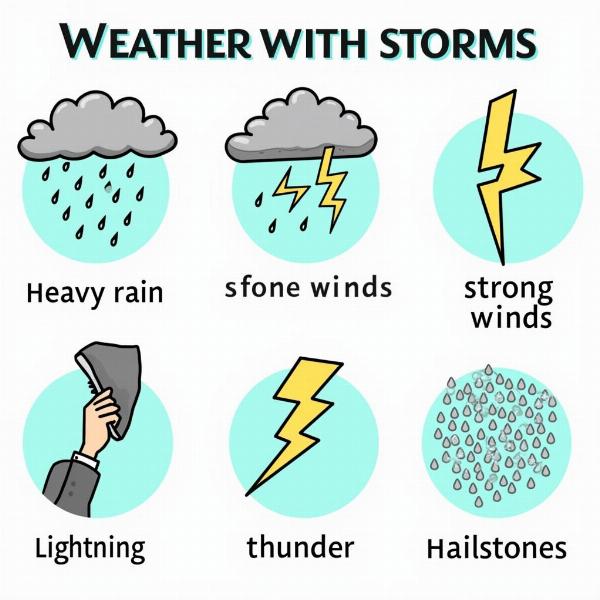Stormy weather, a common occurrence across the globe, carries a specific weight in India due to its monsoon seasons and varied geographical landscapes. Understanding how to express “stormy weather” in Hindi isn’t just about direct translation, it’s about capturing the cultural and contextual nuances associated with it. This article delves into the various ways to describe stormy weather in Hindi, exploring the linguistic subtleties and cultural significance attached to these expressions.
Decoding “Stormy Weather” in Hindi
While a simple translation might suffice in some cases, the beauty of Hindi lies in its ability to express the intensity and type of storm. “Stormy weather” can be translated in several ways, depending on the specific context:
- तूफानी मौसम (Toofani Mausam): This is a general term for stormy weather, encompassing strong winds, heavy rain, and often lightning and thunder. It’s a widely understood and frequently used phrase.
- आँधी तूफान (Aandhi Toofan): This phrase emphasizes a more intense storm, often indicating a powerful windstorm or cyclone. It evokes a sense of chaos and potential destruction.
- बरसात का मौसम (Barsaat ka Mausam): While literally translating to “rainy season,” this phrase can also imply stormy weather, especially during the monsoon when heavy downpours and thunderstorms are prevalent.
- ख़राब मौसम (Kharab Mausam): This is a more generic term for “bad weather,” which can include stormy conditions. It’s a less specific term but still conveys the undesirable nature of the weather.
Cultural Significance of Stormy Weather in India
Stormy weather holds a significant place in Indian culture, particularly relating to agriculture and religious beliefs. The monsoon season, though often associated with storms, is crucial for the country’s agricultural output and is often celebrated with festivals and rituals. Conversely, excessively stormy weather can lead to devastating floods and crop damage, underscoring the delicate balance between life-giving rain and destructive storms. Many deities in Hindu mythology are associated with storms, reflecting the power and awe they inspire. Indra, the king of the gods, is known for wielding the thunderbolt and controlling rain and storms.
Common Hindi Phrases Related to Stormy Weather
Beyond the direct translations, several other phrases in Hindi describe specific aspects of stormy weather:
- ज़ोरदार बारिश (Zordar Barish): Heavy rain
- तेज़ हवाएं (Tez Hawaen): Strong winds
- गरज (Garaj): Thunder
- बिजली (Bijli): Lightning
- ओलावृष्टि (Olavrishti): Hailstorm
 Common Hindi Phrases for Stormy Weather
Common Hindi Phrases for Stormy Weather
What does “mausam kharab hai” mean?
“Mausam kharab hai” simply means “The weather is bad.” It’s a general term and can refer to various unfavorable weather conditions, including stormy weather.
How to describe a thunderstorm in Hindi?
You could describe a thunderstorm as “bijli aur garaj ke saath tez baarish” (तेज बारिश बिजली और गरज के साथ) meaning “heavy rain with lightning and thunder”.
Navigating Stormy Weather Vocabulary
Dr. Anamika Sharma, a renowned linguist specializing in Hindi dialects, states, “Understanding the nuances of Hindi vocabulary related to stormy weather allows for a deeper appreciation of the language and its connection to the environment.” This highlights the importance of going beyond simple translations and delving into the cultural context of language.
Impact of Stormy Weather on Daily Life
Stormy weather significantly impacts daily life in India, affecting transportation, agriculture, and even social gatherings. Schools and businesses might close during severe storms, and people are advised to stay indoors for safety.
Conclusion
Understanding the various ways to express “stormy weather meaning in hindi” provides a deeper understanding of the language’s richness and its connection to the Indian cultural landscape. From the general term “toofani mausam” to more specific phrases describing different aspects of a storm, the Hindi language offers a diverse vocabulary to describe this natural phenomenon. Learning these nuances allows for more effective communication and a deeper appreciation for the intricate relationship between language, culture, and the environment.
FAQ
- What is the most common way to say “stormy weather” in Hindi? The most common way is “toofani mausam” (तूफानी मौसम).
- Does “barsaat ka mausam” always mean stormy weather? Not necessarily. While it translates to “rainy season,” it can imply stormy weather, especially during monsoon.
- What is the Hindi word for lightning? The Hindi word for lightning is “bijli” (बिजली).
- How do you say “heavy rain” in Hindi? “Zordar barish” (ज़ोरदार बारिश) means “heavy rain.”
- What is the significance of stormy weather in Indian culture? Stormy weather is significant in Indian culture due to its impact on agriculture and its association with religious beliefs.
- What word describes a powerful windstorm in Hindi? “Aandhi toofan” (आँधी तूफान) describes a powerful windstorm or cyclone.
- How does stormy weather affect daily life in India? Stormy weather can disrupt transportation, agriculture, and social gatherings, sometimes leading to school and business closures.
Meaning-Hindi.in is your trusted partner for all your Hindi translation needs. We offer a wide range of professional translation services, from business and legal documents to technical manuals and website localization. Our team of expert Hindi translators ensures accuracy, cultural sensitivity, and timely delivery. Whether you need to translate a commercial contract, legal documents, technical specifications, website content, or educational material, we have the expertise to deliver high-quality translations that meet your specific requirements. For accurate and reliable Hindi translations, contact us at [email protected] or call us at +91 11-4502-7584. Meaning-Hindi.in is dedicated to bridging the language gap and facilitating effective communication across cultures.